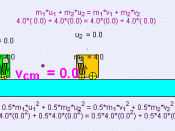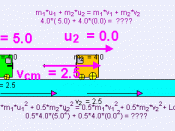INTRODUCTIONResearch Question- Will the momentum of the objects always be conserved in a frictionless situation?Background Information-To fully understand the procedure and the results of the experiments, one must fully understand the concept of impulse and momentum. The dry solid definition of the linear momentum (momentum) of a body is defined as the product of its mass and velocity. The mathematical equation of momentum is P=m*v, where P=Momentum, m=Mass of the object, and v=Velocity of the object. Impulse can be defined as the product of the average net force and the time interval over which it acts. The mathematical equation of impulse isAnother thing that one must know is the impulse momentum theorem. The impulse momentum theorem says that impulse is equal to change momentum. Another word that one must be familiar with is the term collision. Collision, according to Mr. LadbrookÃÂs PowerPoint, can be defined as when two objects exist in the same space at the same time.
There are 2 types of collisions, elastic and inelastic. Elastic collision can be defined as a collision in which the object rebound without any generation of heat energy or without any deformation. (From Mr. LadbrookÃÂs PowerPoint) Inelastic collision can be defined as a collision in which heat may be produced in the collision or the object deforms, a collision is perfectly inelastic if the objects stick together. (From Mr. LadbrookÃÂs PowerPoint) One must also be familiar with the Law of Conservation of Momentum in order to fully understand the experiment. The law basically states that the momentum of any closed system with no net external force does not change. (From Mr. LadbrookÃÂs PowerPoint)Equations Used-P=Momentumm=Massv=VelocityF=Forcet=Change in timep=Change in momentumF=Forcet=Change in timeVelocity= Distance/TimeHypothesis- I hypothesize that momentum will be preserved in all situations. I predict that in the first part, case 1, of...


